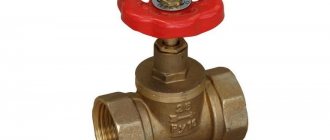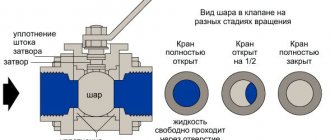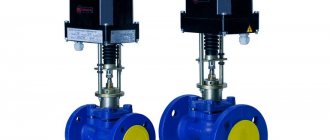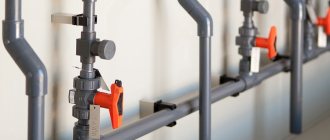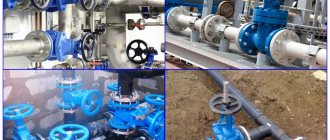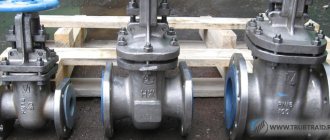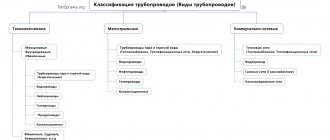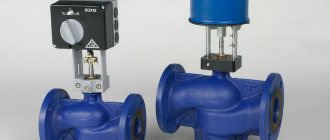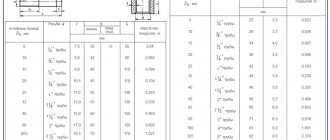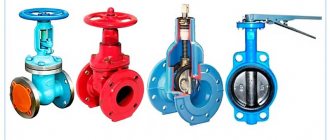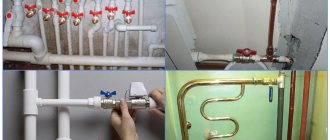Classification of valves (gates) according to the direction of flow of the working fluid:
Based on the design of the body and location on the pipeline (related to the direction of flow of the working medium), shut-off valves are divided into three groups:
- straight-through valves - the direction of the medium flow at the inlet and outlet is the same. The axis of the outlet pipe can be shifted parallel to the inlet pipe. In such a valve, the flow of medium in the body makes at least two turns by 90°, which leads to high hydraulic resistance and the appearance of stagnant zones in the body;
- Angle valves - in these valves the flow turns 90°, but only once, which reduces hydraulic resistance. The disadvantage of such valves is that their scope is limited to rotary sections of pipelines;
- direct-flow valves - in them, as in walk-through valves, the flow direction is maintained, but the spindle axis is not perpendicular, but oblique to the passage axis. This design makes it possible to significantly straighten the flow and reduce hydraulic resistance, but at the same time the valve stroke, face-to-face length and weight of the product increase.
Classification of valves (valves) by gate type:
| shutter type | Valve type | Varieties valves | Examples of valves |
| Membrane | Diaphragm valve | Lined Gummed Enameled | 15h75p2, 15h76p2m 15h73gm, 15h63gm 15h93em, 15h91em |
| Bellows | Bellows valves | Vacuum Bellows Valves Bellows valves | 15b24r, 22b17p 14nzh17st, 15s23p |
| Plate (spool) | Packed shut-off valves | Packed shut-off valves | 15s22nzh, 15nzh65bk |
| Cone | Packed shut-off and control needle valves | Needle valves | 15nzh54bk, 15s92bk |
The sealing surfaces of a poppet valve can be flat or conical; in the latter case, the seat in the body is made in the form of a chamfer. Flat seals can be manufactured from a variety of metals and non-metallic materials. They work well in liquid and gaseous media that do not contain suspended particles. Cone seals, metal to metal, are used for valves for high pressures with suspended particles in the working environment.
The conical valve is used in valves with a nominal diameter of no more than 25, for nominal pressures of 16 MPa and above. Such valves are called needle valves.
Like other types of shut-off valves, shut-off valves (valves) are used to completely shut off their flow area, and, consequently, the flow of the working medium; that is, the locking element, which in a shut-off valve is most often a spool, is in the extreme positions “open” or “closed” during operation.
Design Features
The product is made in the form of a tee with a pipe and two ends for transporting liquid. The design may also have a hole with a valve for draining and a shut-off valve (spool valve) to completely or partially block the flow.
Spindle - another significant element is located in the body saddle; it is used to control the locking device.
The control principle is that the spindle, passing through a hole in the housing, moves the spool, which, when lowered, blocks the flow.
The coupling shut-off valve is mounted using a threaded connection, so the ends of the product are always designed with external or internal threads and are equipped with a coupling - a threaded connecting part.
Manufacturing technology and materials
The production of coupling shut-off and control valves is carried out by casting or stamping. In this case, the material undergoes preliminary testing to ensure compliance with operating standards in a particular environment.
Stainless steel, cast iron and brass are used for production, which are characterized by high performance, long service life and reasonable cost to meet the needs of the buyer.
Brass valves
The brass coupling tap is most often used in cold water supply systems of vertical or horizontal type. The design of the mechanism can be:
- Direct flow. There are no internal metal parts that need protection. The spindle axis in them is located at an angle to the flow line. In this case, low hydraulic resistance is observed. The body of such a valve is long and heavy.
- Angular. Installed at turning or bending points of the highway.
- Direct flow. Its installation is carried out on any section of the pipe. The device is characterized by a high level of hydraulic resistance.
Brass products are characterized by high corrosion resistance, resistance to temperature changes, and resistance to increased pressure within the system.
Cast iron valves
The cast iron coupling valve is distinguished by a powerful body and a control unit based on the spindle. It is designed for pipes with a diameter of 10-300 mm. The body of the part is capable of withstanding pressure up to 15 MPa and heating up to +225°C. In practice, the products are used in low-pressure water pipelines with a liquid temperature of about +50°C. Less often - for transporting steam and gas with prescribed maximum characteristics.
Due to the strength of the body and control mechanism, cast iron taps are widely used not only in everyday life, but also in industry. Their fairly low cost makes them practically irreplaceable. The body of the product is made of gray or ductile cast iron. All parts of the locking unit are made of steel. A rubber or leather gasket is used as a sealing element.
Steel devices
The steel coupling valve has excellent strength, significantly exceeding that of cast iron and brass, but inferior to them in hardness. To improve performance characteristics, alloying elements such as manganese, cobalt, vanadium, chromium, etc. are introduced into the composition.
One type of modified metal is stainless and heat-resistant steel. The cranes have proven themselves well in highways with high temperatures and aggressive environments.
Coupling valves with an “American” mechanism are made from steel, in which union nuts are used instead of hexagonal ends. This design greatly simplifies the installation process, since there is no need to rotate the entire fittings. Fixation is carried out by screwing the nuts separately on each side.
Advantages and disadvantages
Shut-off valves are distinguished by their ability to work in conditions with increased thermal loads and in conditions of high pressure, calmly withstanding pressure changes.
They are easy to install and can be installed anywhere in the pipeline and in any position. They are easy to maintain, also last a long time, take up little space and weigh relatively little.
The disadvantages of valves include a high coefficient of hydraulic resistance, and, as a result, high energy consumption during use.
In addition, the valves do not cope well with transporting a viscous working fluid due to possible stagnation in places where the flow is blocked.
We recommend that you read: How to select and install a ball valve
Cast Iron Flange Valve
In order to operate heat and water supply networks without problems, reliable pipeline fittings are required.
It is impossible to imagine modern shut-off and control valves without one of the most prominent representatives, which is the cast iron flanged valve. These valves:
- They are distinguished by a powerful, reliable body and simple design, which ensures affordable maintenance and repair;
- used when working with liquid and gaseous media;
- designed for extreme temperatures and pressures.
Most often they are used for the full functioning of standard-type water supply systems, as well as pipelines and low-pressure lines that transport superheated air, steam, gas, and water. A very wide range of standard sizes and diameters of products makes it possible to use them both in domestic and industrial conditions.
The price of flanged cast iron valves depends, first of all, on the technical characteristics, as well as on the quality of the material and the manufacturer. Plus, the cost is affected by the type of trading activity: wholesale or retail.
Types of valves with coupling connection
The material used for the manufacture of the coupling device is brass, cast iron or steel:
- Brass products are used mainly in everyday life for arranging plumbing systems. The product is resistant to corrosion, as the copper alloy with the addition of zinc has anti-corrosion properties.
- Cast iron valves work well in environments with high thermal loads. They are used to block the movement of liquid and steam when the highest requirements for tightness and resistance to deformation are applied to pipelines. Cast iron shut-off valves are inexpensive and last a very long time.
- Steel ones combine the properties of brass and cast iron, i.e. they are heat-resistant and do not corrode. Based on the material of manufacture, they are divided into valves made of stainless steel and products made of heat-resistant steel. The former are characterized by increased resistance to corrosion, the latter to high temperatures.
Technical characteristics of various types
Each type of locking coupling units has certain conditions for which they are designed:
| Specifications | Brass | Cast iron | Steel |
| diameter | from 15 to 50 mm | ||
| pressure limit | 16 mPa | ||
| maximum t of the working environment | 225 degrees | 425 degrees | |
| t atmosphere | from - 40 degrees to + 40 degrees | from - 40 to +45 degrees | |
| tightness class | A | D | A |
| life time | 50 | ||
Shut-off valves, bellows. Principle of operation:
| 14nzh17st | 14nzh19p | 15p56p1 | 15s23p |
In bellows fittings, the seal of moving elements relative to the external environment is ensured by a bellows assembly. Its main element is a bellows - a corrugated metal tube. The bellows is connected by welding or soldering to the upper or lower rings (or other shaped parts), forming a so-called bellows assembly. The bellows assembly, with its upper part, is motionlessly and hermetically connected to the body parts of the valve, and the lower part is connected to the valve stem or spool. The forward movement of the rod to control the spool occurs inside the bellows, which can change its length due to the deformation of the corrugations.
Bellows valves are used to operate in environments where leakage into the environment is unacceptable. The advantage of such valves over stuffing box valves is the elimination of leakage of the working medium into the atmosphere within the service life of the bellows assembly. But this advantage is achieved by significantly complicating the design and, accordingly, increasing the cost of the valve. In addition, repairing the valve bellows is a complex operation and is not performed in practice.
Advantages of bellows valves:
- lack of stuffing box;
- no leakage of working fluid into the external environment;
- long service life of valves in corrosive and chemically aggressive environments, elevated temperatures and operating pressures.
Disadvantages of bellows valves:
- the valve cannot be repaired;
- high valve price;
General characteristics of the valve
Any pipeline must have shut-off valves so that, if necessary, it can be closed as soon as possible. Such requirements apply to both domestic and industrial supply systems. The flow is shut off using taps or valves. The choice of one type or another depends on certain characteristics of the pipeline system, the transported medium, goals and circumstances.
The most popular pipeline fitting is the coupling shut-off valve. The fact is that the technical capabilities of the node make it possible not only to block the flow, but also to regulate its characteristics, changing the throughput of the highway and the flow rate of the transported medium.
Taps can only block the supply of media, since in their design the main function is performed by a locking plate or a ball with a through hole. In valves, the flow pressure is regulated by the movement of a reinforced spool, which is capable of taking a perpendicular position or at an angle with respect to the working medium.
A closed valve completely blocks the passage of media through the highway. If you unscrew it a little, the flow will resume its movement, but with less pressure. In this way, it is possible to regulate the speed of the carrier and the pressure in the pipes. Moreover, all internal components and the shut-off valve itself are endowed with properties that protect against damage, water hammer and high pressure. Thanks to the spindle gland seal or bellows protection, accidental leaks are kept to a minimum.
The product is used for both liquid and gaseous carriers with a wide range of parameters. It is installed in almost every pipeline system, which is determined not only by its functionality, but also by the connection method, since it is much easier to work with a coupling valve than with a flanged or welded valve. The service life of all valves is about 50 years under conditions of proper installation, maintenance and care.
Connection classification
Depending on the method of connection to the pipeline, the fittings are divided into:
- flanged - performed using hardware parts (flanges) and a bolt tie. With this connection method, repeated assembly and disassembly of these places is possible for repair or maintenance;
- coupling - couplings with internal threads or smooth ones for welding are used. This connection method is used for pipeline systems made of any materials with a medium pressure not exceeding 16 atm;
- pin-type - fittings for joining pipes have special pipes with external threads;
- fitting - used for devices of ultra-small and small diameters. It is a threaded pair - connecting pipes with external threads and union nuts, with the help of which the product is attracted to the pipeline. This type of connection is sealed using a gasket or a socket method, when the fitting is made with a cone at the end, and the pipe is pressed tightly onto it;
- welded - elements are joined using socket or butt welding. This method ensures maximum tightness of connections and is used for the construction of pipelines transporting hazardous media.
Manufacturers
Brass coupling valve 15b3r in Russia is produced by the following state and private commercial enterprises:
- JSC Bologovsky Valve Plant, abbreviation in the marking of all products BAZ;
- CJSC Saratov Reinforcement Plant;
- Private unitary enterprise (PUE) Tsvetlit;
- Mozhaisk reinforcement plant;
- Perm Fire-Fighting Equipment Plant (Gallop LLC).
Also on the market there are products from Chinese manufacturers without brand logos, with a Russian brand (Zubr) or little-known brands.
Rice. 5 Price list for products in the selling commercial company BK-Armatura
Shut-off brass valves of the 15b3r series have a standard design and are used in both industrial and domestic areas; corner models are widely used in fire extinguishing. When choosing a product, they consider products from Russian and Chinese manufacturers, which are distinguished by good quality and affordable prices.
Classification of fittings
To choose the right type of fittings for a pipeline, you should familiarize yourself with the design features, operating principles and main parameters of various models, and taking into account their technical characteristics and properties, select the best option.
So, shut-off and control devices for liquid and gaseous media supply systems are divided into:
- valves - a type of pipeline fittings in which the shut-off or control valve moves in a parallel direction to the flow axis, its movement is set using a screw pair;
- valves - primarily used as a shut-off device for starting or cutting off the flow of a moving substance. When triggered, their working body moves back and forth in a direction perpendicular to the impulse line;
- gates - a disc-shaped locking part moves perpendicular to the direction of flow, while rotating around its axis;
- taps - a locking or regulating part is made in the form of a rotating body or its segment, upon receiving a control signal it moves translationally - rotationally across the central axis of the outlet;
- valves - in them the locking or regulating body moves reciprocatingly - progressively or arcuately along the flow axis.
Installation
In order to install a coupling valve, first shut off the flow of liquid or gas. Heating systems drain water. The location of the tap is then marked, ensuring easy access in all directions. The process can be divided into several stages:
- A section is cut out of the pipe perpendicular to the walls, the length of which corresponds to the dimensions of the installed fittings.
- The edges are threaded. It will match the parameters of the turns on the coupling. The remaining shavings are removed.
- To ensure high tightness, a seal made of flax threads or FUM tape is screwed on (depending on operating conditions).
- Taking into account the direction of movement indicated on the body, the valve is screwed onto the pipes. The fitting is screwed onto both ends at the same time.
- Supply fluid and check for leaks. Troubleshoot if necessary.
Installation and repair are carried out using a similar method - by screwing on and unscrewing the threaded connection, which makes coupling valves in demand. Most often, rubber gaskets fail because they dry out or become depleted, but the ease of replacement and low cost of the part cause virtually no inconvenience.
